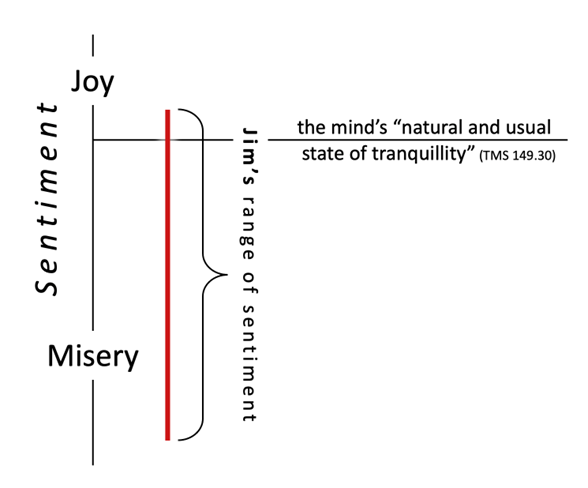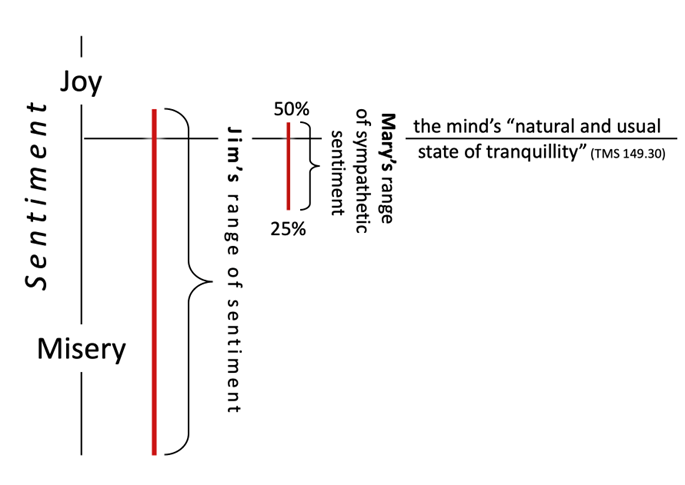Alshamy & Klein: Adam Smith on upside and downside
”Smith saw that the depths of the downside—misery, suffering, anguish—are deeper, more profound, and more enduring than the heights of the upside—levity and joy.”
In the article “Adam Smith, Behavioral Economist,” Nava Ashraf, Colin F. Camerer, and George Loewenstein (2005) explain that many findings of modern behavioral research were anticipated by Adam Smith. One such rubric is loss aversion. Smith gives a concise statement of loss aversion: “We suffer more…when we fall from a better to a worse situation, than we ever enjoy when we rise from a worse to a better” (TMS 213.6).
The term “loss aversion” may seem strange: Isn’t it redundant to say that we are averse to losses? But “loss aversion” says, moreover, that our aversion to losses is more than our keenness for gains. Losses loom larger than commensurate gains. Losing $10,000 matters more than gaining $10,000. Losing a son or daughter matters more than gaining a son or daughter.
Call the scope of potential gains the upside, and of possible losses the downside. In this article, we explain the fundamentals of Smith on upside and downside. We consider upside and downside both for the person experiencing them—call him Jim—and for the person who sympathizes with Jim—call her Mary.
Smith saw that the depths of the downside—misery, suffering, anguish—are deeper, more profound, and more enduring than the heights of the upside—levity and joy. There is an experiential asymmetry between losses and gains.
As for Mary, Smith argues that when Mary sympathizes with Jim, the sentiment she feels when Jim experiences the upside is weaker or less penetrating that when he experiences the downside. Her sympathetic sentiment on the upside is, however, more complete than on the downside.
Smith would not call loss aversion a “bias” (see TMS 306.2). That term indicates a tendency that needs correcting. The asymmetries of loss aversion are part of man’s nature and proper moral psychology. Smith speaks of the asymmetries repeatedly in The Theory of Moral Sentiments (TMS) and the Lectures on Rhetoric and Belles Lettres (LRBL), and occasionally in the Lectures on Jurisprudence (LJ). As for the Wealth of Nations (WN), it at least implies the asymmetry in some spots, for example in emphasizing the importance of security of possessions and certainty of rules, for confidence, investment, and economic growth (e.g., 910.7, and see Irwin 2019).
Baselines in Adam Smith
Speaking of upside or downside presupposes a baseline from which we speak of movement up or down. The same is true of gain and loss. We tacitly suppose a baseline of some kind.
In WN, Smith emphasizes a human propensity: “[t]he uniform, constant, and uninterrupted effort of every man to better his condition” (343). He says that “the progressive state”—in which society experiences economic improvement—is “the chearful and hearty state to all the different orders of society” (99.43).
In TMS, however, Smith suggests that, in terms of one’s sense of well-being, there is little difference between one “permanent situation” and another. He even says that “The great source of both the misery and disorders of human life, seems to arise from over-rating the difference between one permanent situation and another” (TMS 149.31).
Perhaps Smith’s thinking here can be resolved if one’s situation involves a framework of striving. We improve our material condition but maintain our striving—and soon find our enjoyment of life little changed. In the parable of the poor man’s son in TMS, Smith even suggests that riches can be a curse, for they leave us vulnerable and anxious about maintaining our condition, our “enormous and operose machines” (TMS 182.8). Smith teaches a certain equanimity in our continual striving: Don’t expect experience to become much better.
After experiencing a change, men, “sooner or later, accommodate themselves to whatever becomes their permanent situation”; “the mind of every man, in a longer or shorter time, returns to its natural and usual state of tranquillity. In prosperity, after a certain time, it falls back to that state; in adversity, after a certain time, it rises up to it” (TMS 149.30).
Smith writes of “a man who has lost his leg by a cannon shot”:
By the constitution of human nature, however, agony can never be permanent; and if he survives the paroxysm, he soon comes, without any effort, to enjoy his ordinary tranquillity. A man with a wooden leg suffers, no doubt, and foresees that he must continue to suffer during the remainder of his life, a very considerable inconveniency. He soon comes to view it, however, exactly as every impartial spectator views it, as an inconveniency under which he can enjoy all the ordinary pleasures both of solitude and of society. (TMS 148.29)
Among permanent situations, some are “the natural and ordinary state of mankind.” To explain this class of permanent conditions, Smith writes:
What can be added to the happiness of the man who is in health, who is out of debt, and has a clear conscience? To one in this situation all accessions of fortune may properly be said to be superfluous; and if he is much elevated upon account of them, it must be the effect of the most frivolous levity. This situation, however, may very well be called the natural and ordinary state of mankind. (TMS 45.7, boldface added)
Good health, out of debt, clear conscience—this, it seems, is a baseline for those so blessed. And Smith says that it is the state of most of us: “Notwithstanding the present misery and depravity of the world, so justly lamented, this really is the state of the greater part of men” (Ib.). Later in the text, Smith says that “in all the ordinary situations of human life, a well-disposed mind may be equally calm, equally cheerful, and equally contented” (149.31)—and later goes so far to say that “the beggar, who suns himself by the side of the highway [Diogenes of Sinope], possesses that security which kings [such as Alexander] are fighting for” (TMS 185.10).
As for those of ill health, debt, or murky conscience, it seems that each such person, too, has a “natural and usual state” of mind. In a permanent situation, a person psychically settles into the state of mind “natural and usual” to himself or herself. And in LRBL, Smith speaks of “the ordinary pitch of human happiness” (85). All of these “natural” or “ordinary” states of mind—with or without troubled health, debt, or conscience—make for baselines in Smith’s thoughts about upside and downside.
The upside is shallow
Speaking of the natural and ordinary state of mankind, Smith said: “[B]etween this condition and the highest pitch of human prosperity, the interval is but a trifle” (TMS 45.8). Thus, the upside from the natural and ordinary state of mankind is shallow—a trifle. Extended displays of joy are regarded as “frivolous levity,” perhaps affectation (TMS 45.7). Exultation is rare and elation is fleeting.
The downside is deep
Think about your leg being blown off, or your home burning down, or your career being destroyed, or your son or daughter being killed by a drunk driver. What possible gains are experientially symmetric to such losses?
“Though little can be added to [the natural and ordinary state of mankind], much may be taken from it.” The interval is “immense and prodigious.” Thus we have asymmetry: “Adversity…necessarily depresses the mind of the sufferer much more below its natural state, than prosperity can elevate him above it” (45.8). Also, the psychological asymmetry parallels a sensory asymmetry, for pain, “is a more pungent sensation than pleasure” (TMS 44.3, 121.15). Another asymmetry that relates is that between destruction and construction: An arsonist can destroy a beautiful object that required years of immense care to construct. (For a nice presentation of a wide variety of asymmetries, see The Power of Bad by John Tierney and Roy F. Baumeister 2019.)
The figure below shows the asymmetry, with the mind’s “natural and usual state of tranquillity” as the baseline:

Some proofs of the asymmetry between upside and downside
Many illustrations and implications of the asymmetry are provided in Smith’s writings:
- The concept of loss aversion relates to the idea of an attachment or fondness for one’s familiar possessions, circumstances, and routines or habits, sometimes called the endowment effect or status-quo bias. Smith writes: “A man grows fond of a snuff-box, of a pen-knife, of a staff which he has long made use of, and conceives something like a real love and affection for them” (TMS 94.2).
- Because the upside is shallow, someone who has the self-command to limit his expression of joy is not particularly deserving of praise (TMS 45.6), whereas command of grief and anguish inspires admiration (TMS 24.3, 31.12, 45.6).
- Smith notes that in literature grief and uneasiness leave the most profound effects—thus Smith’s reverence for Thucydides (LRBL 84–87).
- Smith notes that we tend to be more humiliated by merited blame than pleased by merited praise (TMS 112.5, 123.19). And in contrast to what a man feels in the case of unmerited applause, even a wise man is affected by unmerited censure (TMS 119.11, 121.15).
- As for prudence, the asymmetry has a clear consequence: “Security, therefore, is the first and the principal object of prudence. It is…more anxious to preserve the advantages which we already possess than forward to prompt us to the acquisition of still greater advantages” (213.6).
- The asymmetry is recognized in law: “breach of property, therefore, theft and robbery, which take from us what we are possessed of, are greater crimes than breach of contract, which only disappoints us of what we expected” (TMS 84.3; LJ 87–88, 472). As for the propertization of objects, possession of objects previously unowned forms a basis for ownership (LJ 21), as does prescription for objects previously owned and for unclaimed debts (LJ, 32, 484). As for the extending of the convention of ownership to more and more objects, it is a gradual process dependent upon people feeling, as permanent situation, that they own the objects to which the convention was lately extended (LJ 19–25). Also, Smith invokes loss aversion to explain why rulers may more easily claim rights to their subjects’ adventitious discoveries, such as treasure-troves, than to their ordinary possessions (LJ 25).
Why are upside and downside so asymmetric?
Being vulnerable organisms, susceptible at every moment to that finality, death, we are anxious about dangers, including losses that would jeopardize survival. God, evolution, or both selected for the asymmetry between upside and downside (LRBL 85; TMS 212.1). Self-preservation is not always aligned with propagation of the species, but one can hardly imagine the latter without some strong natural instinct toward self-preservation.
As for the proximate causes of the asymmetry in the moment, for each of us, that is not something that Smith treats compactly. More diffusely, the whole of his moral psychology conveys this salient aspect of human nature. To address the question, we offer a compact Smithian explanation in the following paragraph.
Beyond the basics of material condition, our well-being is primarily an affair of moral condition, and our moral condition concerns our actions in our moral world. Our moral world is built, layer upon layer, from social experiences, our perceptions of proprieties, incorporating certain social influences, into our conscience. Our senses of propriety become second nature, based on our routines, practices, and habits. Our moral condition depends on approval from our conscience, “the man within the breast,” who judges whether we are making a becoming use of what is our own—distributive justice. Habits of body, mind, and heart are an accumulation, an assemblage, an accretion over time, analogous to “enormous and operose machines.” Now, regarding significant changes, consider first the upside: Gains are novelties not yet incorporated into our personal system of distributive justice, and therefore need not affect the continuity and functionality of the system, which remains intact; over time we may learn how to incorporate the newly attained objects. Changes on the downside are another story, however: To lose something upon which we have built up our practices and habits, our “machinery,” is to throw the personal system of distributive justice into disarray—like the failure of an O-ring causing the 1986 Challenger disaster. A loss may leave us in great confusion and anguish as to how, now, after the loss, to make a becoming use of what is our own, and thereby how to earn the approval of our conscience. We may become “a mess,” “a wreck,” at the edge of despair.
Mary’s sympathetic sentiment with Jim
Now let’s turn to Mary, who enters into Jim’s situation and sympathizes. As Smith exposits the sympathetic sentiment, he tends to put envy aside; that is, he supposes that Mary is not envious or invidious toward Jim. That might be Smith’s way of inspiring his readers not to be.
The following figure adds Mary’s sympathetic sentiment:
On the upside, Mary can sympathize more completely with Jim’s joy (in the figure, up to 50%) than with Jim’s suffering (only up to 25%), but in an absolute sense the sympathetic sentiment on the upside is weaker (shorter) than on the downside. Putting us in Mary’s position, Smith states this result in the title of a chapter: “though our sympathy with sorrow is generally a more lively sensation than our sympathy with joy, it commonly falls much more short of the violence of what is naturally felt by the person principally concerned [Jim]” (43). Upside sympathy is more complete, and yet smaller, than downside sympathy.
Smith emphasizes that there is a pleasure in the sharing of sentiment (or, in sympathy). But the sentiment that is shared may itself be unpleasant or even painful. Thus, unpleasant-sentiment sharing (compassion, commiseration) mixes pleasure with pain, while pleasant-sentiment sharing (felicitation, congratulation, celebration) does not.
Jim’s downside sentiment is painful—it may be horrible, terrible. Also, Jim’s loss causes upset to his personal system in ways that others may little understand. Leo Tolstoy suggested that all happy families are alike but each unhappy family is unhappy in its own way (Tierney and Baumeister 2019, 9). For Mary, it is difficult to imagine and understand Jim’s upset.
Smith explains that Mary, though a friend, is unable or unwilling to descend deeply into Jim’s suffering. Furthermore, Jim suppresses his expression of misery—in part because Jim himself sympathizes with Mary’s situation as a sympathizer. Jim understands that expressing the full extent of his misery would burden Mary (TMS 24.4; LRBL 87.7); Jim therefore is called upon to show the “respectable” virtues of lowering the “pitch” of his sentiment (TMS 22–23). Still, if Mary is a good friend, she goes some way with Jim’s suffering, for there is comfort in commiseration. In LRBL (85), Smith says, “it is with the misfortunes of others that we most commonly as well as most deeply sympathise.”
On the upside, by contrast, Mary enjoys the fellow-feeling of sympathizing with Jim’s joy (TMS 45.5). And Jim is not so concerned about burdening Mary and may express his sentiments without much inhibition (TMS 45.9). Think of the victorious tennis player after the winning point: In relief and joy, he drops to court and then rises, looks to his team in his box, raises his arms, and smiles. The scene is cathartic and enchanting—for a moment. We know it is not long enduring, and so the absolute height or liveliness of our sympathetic sentiment is not that great even in such a supreme moment of success.
Here, we have presented the fundamentals of Smith on upside and downside. We intend to follow up this article with another, “Heroes and Villains: An Extrapolation of Adam Smith on Upside and Downside.”
Yahya Alshamy is a third-year PhD student in economics at George Mason University, a F.A. Hayek Program Fellow at the Mercatus Center and a Fellow of the Adam Smith Program at GMU Economics. He earned his BS degree in economics from George Mason. His research interests include economic development, institutional economics, and defense, peace, and war economics.
Daniel B. Klein is professor of economics and JIN Chair at the Mercatus Center at George Mason University. His books include Central Notions of Smithian Liberalism and Smithian Morals.
This essay was first published at AdamSmithWorks as a part of the series Just Sentiments
References
Ashraf, Nava, Colin F. Camerer, and George Loewenstein. 2005. Adam Smith, Behavioral Economist. Journal of Economic Perspectives 19(3), 131–145.
Irwin, Douglas A. 2019. Adam Smith’s ‘Tolerable Administration of Justice’ and the Wealth of Nations. Scottish Journal of Political Economy 67(3): 231–247
Smith, Adam. 1976 (TMS). The Theory of Moral Sentiments. D.D. Raphael and A.L. Macfie (Eds.). Oxford University Press; Liberty Fund (1982).
Smith, Adam. 1976 (WN). An Inquiry into the Nature and Causes of the Wealth of Nations. R.H. Campbell, A.S. Skinner and W.B Todd (Eds). Oxford University Press. Liberty Fund (1981).
Smith, Adam. 1983 (LRBL). Lectures on Rhetoric and Belles Lettres, ed. J. C. Bryce. Oxford: Clarendon Press; Liberty Fund (1985).
Smith, Adam. 1978 (LJ). Lectures on Jurisprudence. R. L. Meek, D. D. Raphael, and P. G. Stein (Eds.). Indianapolis, IN: Liberty Fund (1982).
Tierney, John and Roy F. Baumeister. 2019. The Power of Bad: How the Negativity Effect Rules Us and How We Can Rule It. NY: Penguin Press.
Tolstoy, Leo. 1954. Anna Karenina (Rosemary Edmonds, Trans). Middlesex, England: Penguin Book Ltd.
